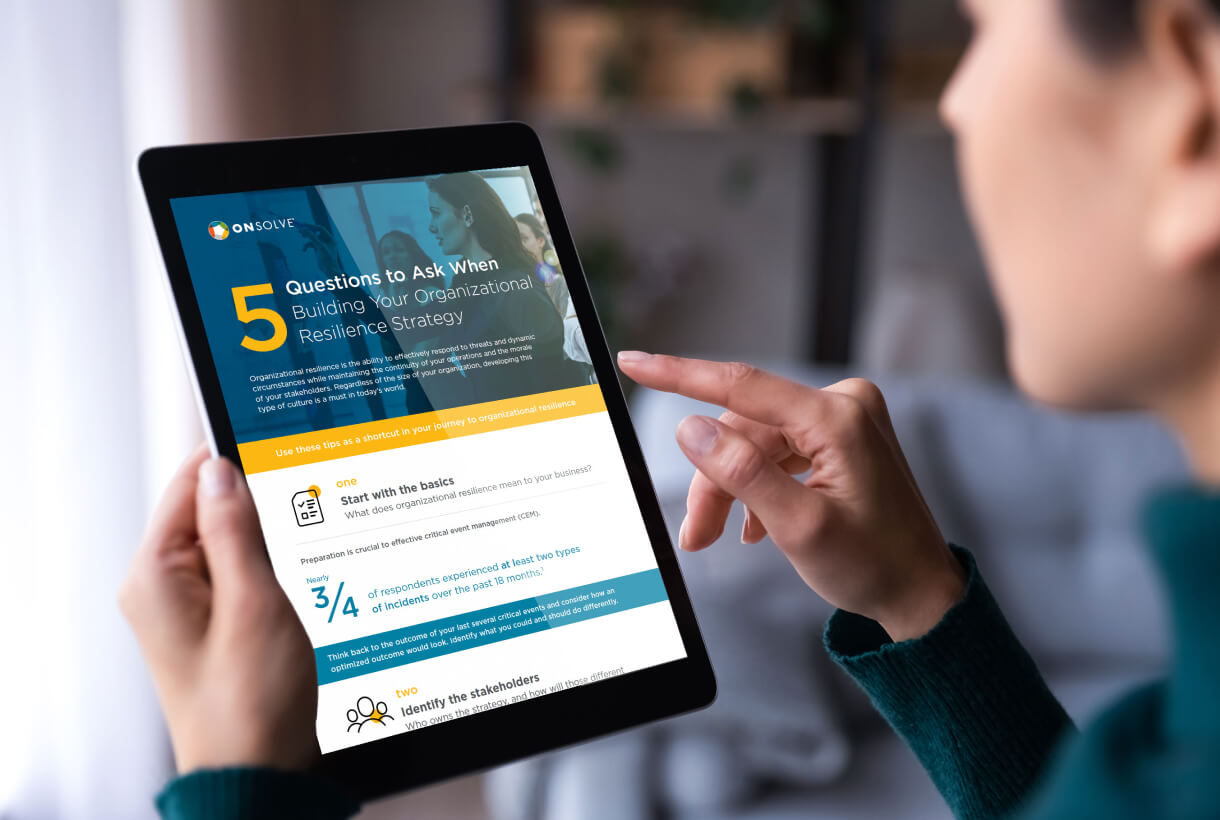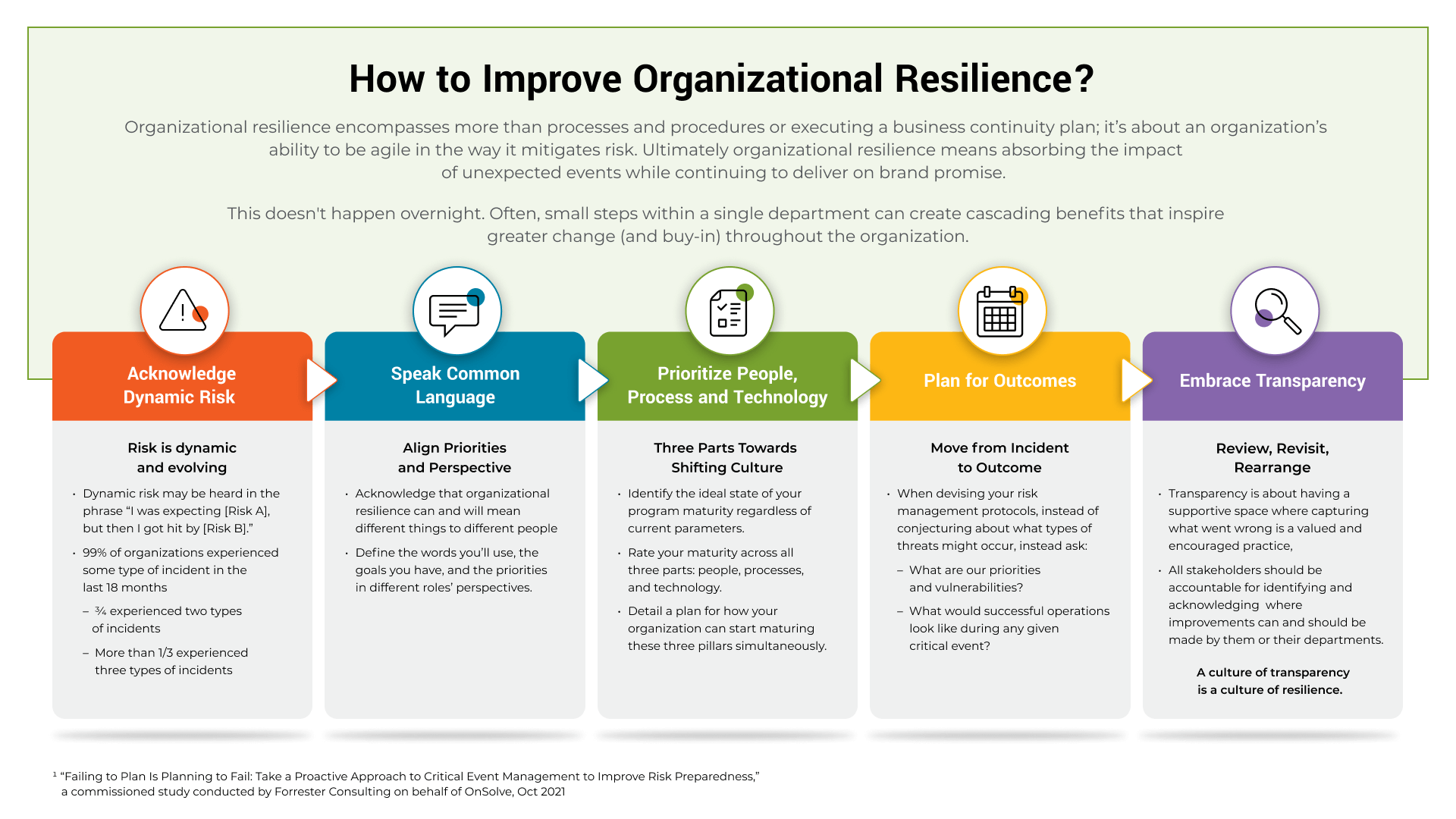Glossary Term:
Organizational Resilience
See why we’re different
Award-Winning Critical Communications
Find out why over 30,000 organizations across the globe rely on OnSolve to deliver fast, effective alerts when they matter most.
Fast, Relevant Risk Intelligence
Discover how AI-powered and analyst-vetted risk intelligence allows you to respond faster and improve outcomes when a critical event occurs.
Unmatched Expertise & Ease of Use
Learn how our power is in our people with decades of experience. We understand the challenges you face every day, and our platform was designed with you in mind.
Have communication challenges?
What is Organizational Resilience?
In 2017, David Denyer, a professor at Cranfield University, defined organizational resilience as the ability of an organization to anticipate, prepare for, respond and adapt to incremental change and sudden disruptions in order to survive and prosper.
Five years later, this definition is more relevant than ever. But the key is to define what it means to you and your organization.
As the risk landscape becomes more dynamic, organizations are increasingly facing simultaneous or a succession of critical events. For example, a hurricane on the East Coast changes direction and causes unexpected flooding that impacts your branch offices in the Midwest. You prepared for the hurricane and had a plan in place; but were you able to pivot to address the unexpected impact to your business several states away?
How Does OnSolve® Strengthen Resilience?
OnSolve helps strengthen organizational resilience to reinforce enterprise, government and business-wide agility during daily operations and times of disruption through integrated technology and expertise.
Incidents can occur in the blink of an eye. Organizations need state-of-the-art technology and expertise on their side to effectively anticipate, prepare, respond and adapt. Survival isn’t enough — today organizations must also thrive after a crisis.
Add and Manage Contacts
- Add or edit them manually
- Import them from a spreadsheet
- Synchronize information with an existing database
Choose Who, How, and When
- Choose who you want to receive the message
- Pick the channel: Voice message, text message or email (or all 3)
- Hit “send” for immediate delivery, or schedule to deliver later
Get Useful Feedback Reports
- Know who received your message and when
- Get answers to any questions you asked in your message
- Easily identify any numbers or addresses that were undeliverable
How do You Measure Organizational Resilience?
Every organization wants to be agile enough to mitigate the risks to their people and property. But often, there’s confusion about where to start and what the next step (or ten steps) should look like.
If we take a step back, understanding organizational resilience first requires understanding that it is also inherently dynamic; it can and will mean different things to different people within your organization. Every leader—whether focused on business continuity, communications, physical security, IT, etc.— will see organizational resilience through a unique lens that’s formed by their role, priorities, and comprehension of the current and future risk landscape. So, it’s essential that any organizational resilience conversation be a collaborative one. That’s because it’s a continuing journey and something an organization must commit to working at (and refining and improving) over the long term.
Why does Organizational Resilience matter?
Too often, the impulse is simply to add another piece of software. But that’s short-sighted. What’s really needed to strengthen organizational resilience is embracing a holistic approach that combines a modern, integrated technology platform with a shift in mindset organization-wide. Every department must have an understanding of how their people and their work support overall corporate objectives, and, just as important, be aligned with the top-level goals of agility, flexibility and ultimately, resilience.
How can you improve Organizational Resilience?
An organization cannot over-prepare. You should be having a conversation about organizational resilience—a way to make better decisions that drive better outcomes. It starts with adopting an organization-wide mindset that emphasizes being agile, curious and adaptive in thinking about and approaching risk. Don’t be afraid of asking questions and analyzing your organization’s strengths and weaknesses. An organizations’ people, processes and technology often mature at different rates, and it’s important to understand where your organization’s leaders believe themselves to be on the technology maturity scale. After all, to determine the best path to your desired destination, you must know your starting point.

5 Questions to Ask When Building Your Organizational Resilience Strategy
Follow these tips to build a culture of organizational resilience.

